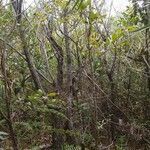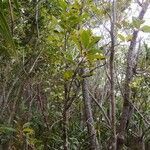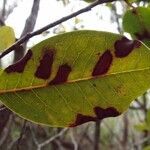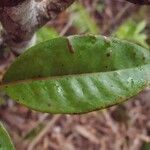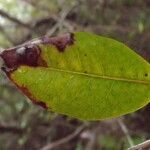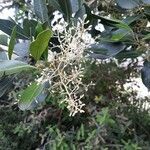Trees or much branched shrubs up to 25 m. high, the larger trees with fluted trunks.. Bark smooth, grey; young branches glabrous to sparsely pubescent; older branches grey-brown with pale lenticels.. Leaf-blade very variable, ovate-elliptic or broadly elliptic to oblong, 2–15 cm. long, 1.5–8 cm. wide, shortly acuminate or acute to obtuse, cuneate, subcoriaceous to coriaceous, the margin slightly recurved, with the midrib impressed above, prominent beneath, and the secondary veins inconspicuous, turning black on drying.. Flowers many, usually in terminal panicles, rarely axillary, shortly pedicellate or sessile, sweet-scented; bracts minute or absent.. Calyx small, up to 0.5 mm. long, with 5 deltoid lobes.. Petals 5, free, white, drying black, linear, ± 5 mm. long and 1 mm. wide.. Ovary ovoid, up to 0.7 mm. long; style eccentric, with the stigmatic surface slightly enlarged at apex, persistent.. Fruit oblique, asymmetric, oblong-obovate, laterally compressed, 5–11 mm. long, 5–9 mm. high, 3–4 mm. wide, glabrous or pubescent, black with the lateral lobe red.
Shrubs or trees, (3-)7-10(-20) m tall. Bark gray-white, smooth; branchlets gray-brown, lenticellate; young branches densely yellow puberulent. Petiole 1-2.5 cm, densely puberulent when young, becoming sparsely so; leaf blade adaxially yellow-green, black or black-brown when dry, elliptic or narrowly elliptic, 6-15 × 3-7.5 cm, glabrous or abaxially on midvein slightly hairy, lateral veins 5-8 pairs, conspicuous abaxially, reticulate veins slender, base cuneate, apex acute or shortly acuminate. Panicles terminal, densely yellow puberulent. Flowers light yellow or white; pedicel shorter than 1 mm, densely yellow puberulent. Calyx yellow-green, ca. 0.5 mm, outside sparsely puberulent. Petals yellow-green, oblong, ca. 4 × 1 mm. Filaments purple-green, ca. 1.5 mm; anthers yellow-green, ca. 1.5 mm. Ovary ca. 1.5 mm, densely yellow pubescent; style ca. 2.5 mm, glabrous. Drupe green when young, red to black-red when mature, oblong, ca. 10 × 7 mm, base with a discoid fleshy appendage, with persistent style. Fl. and fr. all seasons.
Leaf-lamina 2–15 × 1·2–8 cm., ovate-elliptic or broadly elliptic, slightly glossy or ± glaucous or pruinose, subcoriaceous, apex emarginate or obtuse or acute or shortly acuminate, margin entire or sometimes undulate and slightly recurved, midrib slightly impressed above and prominent beneath, venation obscure; petiole 1–3 cm. long, flattened and channelled above.
A shrub or tree. It grows 7-10 m tall. It can grow 25 m high. Large trees have fluted trunks. The bark is smooth and grey. The leaves vary. They can be oval or oblong. They are 2-15 cm long by 2-8 cm wide. The flowers are in large groups at the ends of branches. The fruit is flattened and oblong. It is 8 mm long. They are black when ripe with a red attachment.
An evergreen tree up to 5–15 m. or a shrub; young branches purplish-green with appressed pale brown hairs; older twigs dark grey with pale lenticels; sap-wood very narrow; heart-wood extremely hard and pink or pale violet in colour; bark smooth, grey.
Flowers 2 mm. long in bud, sessile or shortly pedicellate, with very minute or obsolete bracts and bracteoles, in terminal, loose or subthyrsiform many-flowered sweet-scented panicles.
Fruit 0·6–0·7 × 0·5–0·7 × c. 0·3 cm., ovoid-reniform, subcompressed, black, with a persistent style and a fleshy lateral red (drying black) appendage.
Anthers linear, bilobed-sagittate at the base.
Petals white, drying black, 5 × 1 mm, linear.
Calyx 0·3–0·5 mm. long, 5-fid; lobes deltate.
Ovary ovoid.
